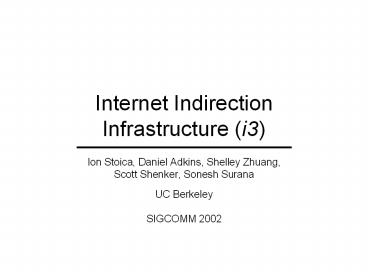Internet%20Indirection%20Infrastructure%20(i3) PowerPoint PPT Presentation
Title: Internet%20Indirection%20Infrastructure%20(i3)
1
Internet Indirection Infrastructure (i3)
- Ion Stoica, Daniel Adkins, Shelley Zhuang,
- Scott Shenker, Sonesh Surana
- UC Berkeley
- SIGCOMM 2002
2
Motivations
- Todays Internet is built around a unicast
point-to-point communication abstraction - Send packet p from host A to host B
- Point-to-point communication
- Implicitly assumes there is one sender and one
receiver, and that they are placed at fixed and
well-known locations - Example a host identified by the IP address
128.111.xxx.xxx is located in UCSB
3
Motivations
- This abstraction allows Internet to be highly
scalable and efficient, but - not appropriate for applications that require
other communications primitives - Multicast
- Anycast
- Mobility
- Key Observation Virtually all previous proposals
use indirection - Physical indirection point ? mobile IP
- Logical indirection point ?IP multicast
4
Solution
- Use an overlay network to implement this layer
- Incrementally deployable dont need to change IP
5
Solution
Multicast
Anycast
Mobility
Service Composition
An indirection layer based on overlay
network (decouples sending and receiving)
DHT
IP Layer
6
Internet Indirection Infrastructure (i3)
- Each packet is associated an identifier id
- To receive a packet with identifier id, receiver
R maintains a trigger(id, R) into the overlay
network
7
Service Model
- API
- sendPacket(p)
- insertTrigger(t)
- removeTrigger(t) // optional
- Best-effort service model (like IP)
- Triggers periodically refreshed by end-hosts
- ID length 256 bits
8
Mobility
- Host just needs to update its trigger as it moves
from one subnet to another
Sender
9
Multicast
- Receivers insert triggers with same identifier
- Can dynamically switch between multicast and
unicast
Sender
Receiver (R1)
Receiver (R2)
10
Anycast
- Use longest prefix matching instead of exact
matching - Prefix p anycast group identifier
- Suffix si encode application semantics, e.g.,
location
11
Using i3
- Service Composition
- Server initiated
- Receiver initiated
- Large Scale Multicast
12
Service Composition Sender Initiated
- Use a stack of IDs to encode sequence of
operations to be performed on data path
S_MPEG/JPEG
Receiver R (JPEG)
Sender (MPEG)
ID
R
ID_MPEG/JPEG
S_MPEG/JPEG
13
Service Composition Receiver Initiated
- Receiver can also specify the operations to be
performed on data
S_MPEG/JPEG
Receiver R (JPEG)
Sender (MPEG)
14
Large Scale Multicast
- Can create a multicast tree for scalability
(g, data)
g R2
g R1
g x
R2
x R4
x R3
R1
R3
R4
15
Implementation Overview
- ID space is partitioned across infrastructure
nodes - Each node responsible for a region of ID space
- Each trigger (id, R) is stored at the node
responsible for id - Use Chord to route triggers and packets to nodes
responsible for their IDs - O(log N) hops
16
Properties
- Robustness, Efficiency, Scalability, Stability
- Robustness refresh triggers , trigger
replication, back-up triggers - Efficiency Routing optimizations
- Incremental deployment possible
- Legacy applications can be supported by proxy
which inserts triggers on behalf of client
17
Example
- ID space 0..63 partitioned across five i3 nodes
- Each host knows one i3 node
- R inserts trigger (37, R) S sends packet (37,
data)
18
Example
- ID space 0..63 partitioned across five i3 nodes
- Each host knows one i3 node
- R inserts trigger (37, R) S sends packet (37,
data)
19
Optimization Path Length
- Sender/receiver caches i3 node mapping a specific
ID - Subsequent packets are sent via one i3 node
20
Optimization Location-aware Triggers
- Well-known (public) trigger for initial
rendezvous - Exchange a pair of (private) triggers
well-located - Use private triggers to send data traffic
Private Triggers - S can insert a trigger 1,S
that is stored at server 3 - R can chose a
trigger 30,R that is stored at server 35
21
Security
- i3 end-points also store routing information
- New opportunities for malicious users
- Goal make i3 not worse than todays Internet
22
Some Attacks
23
Solutions
- Eavesdropping Use private triggers, periodically
change them, multiple private triggers - DoS Attacks Challenges, Fair Queueing for
resource allocation, loop detection - Dead-End Use push-back
24
Experimental Results
- Simulation over two topologies
- Power-law random graph topology
- Transit-stub topology
- Latency Stretch (i3 latency)/(IP latency)
- First Packet Latency, End-to-end Latency
25
First Packet Latency
- Heuristics
- Closest Finger Replica Store r successors of
each finger - Closest Finger Set Use base b lt 2 to find
fingers, but consider only log2N closest fingers
when routing
90th percentile latency stretch vs. no of i3
servers for Transit-stub topology
26
End-to-end Latency
- 90th percentile latency stretch vs. no of samples
(16384 i3 servers) - i3 latency (sender to i3 server)(i3 server to
receiver)
27
Conclusions
- Indirection key technique to implement basic
communication abstractions - Multicast, Anycast, Mobility,
- This research
- Advocates for building an efficient Indirection
Layer on top of IP - Explores the implications of changing the
communication abstraction
28
Status
- http//i3.cs.berkeley.edu/
- i3 is available as a service on Planetlab
- Support for legacy applications in Linux and
Windows XP - Applications
- Mobility
- Transparent access to machines behind NATs
- Secure and transparent access to services behind
firewalls

